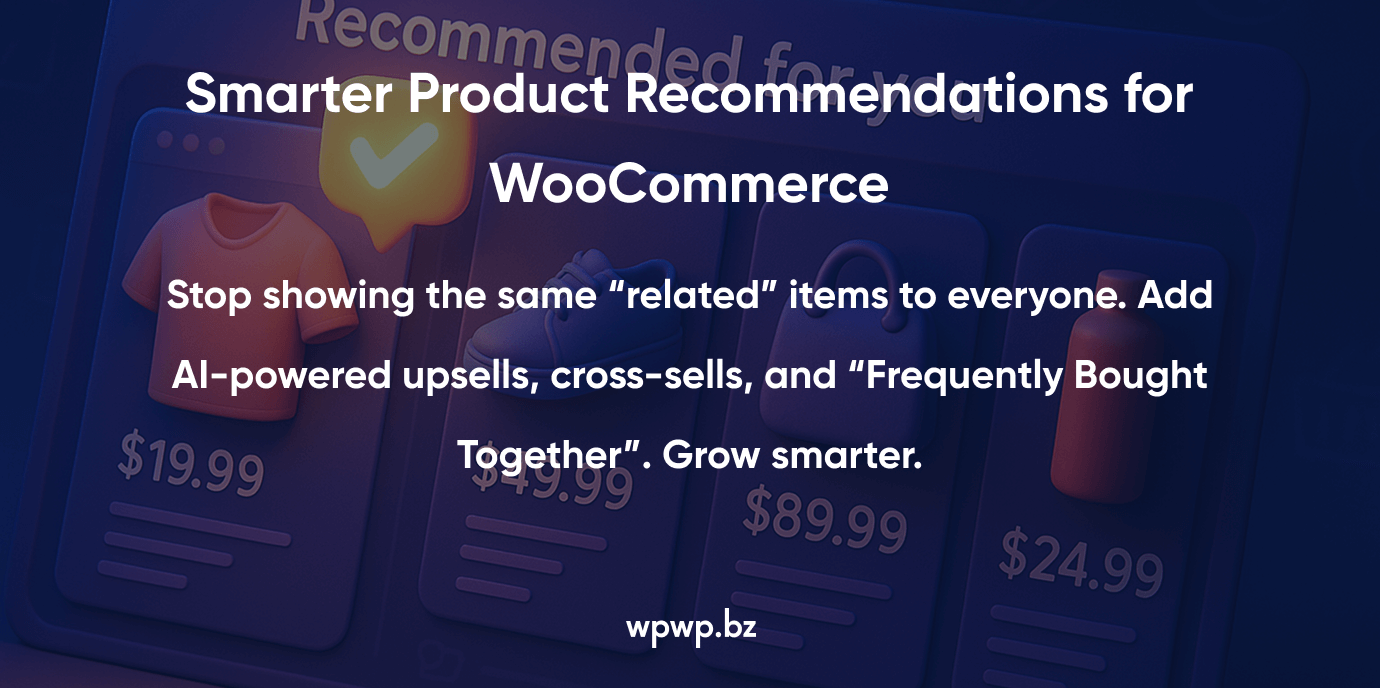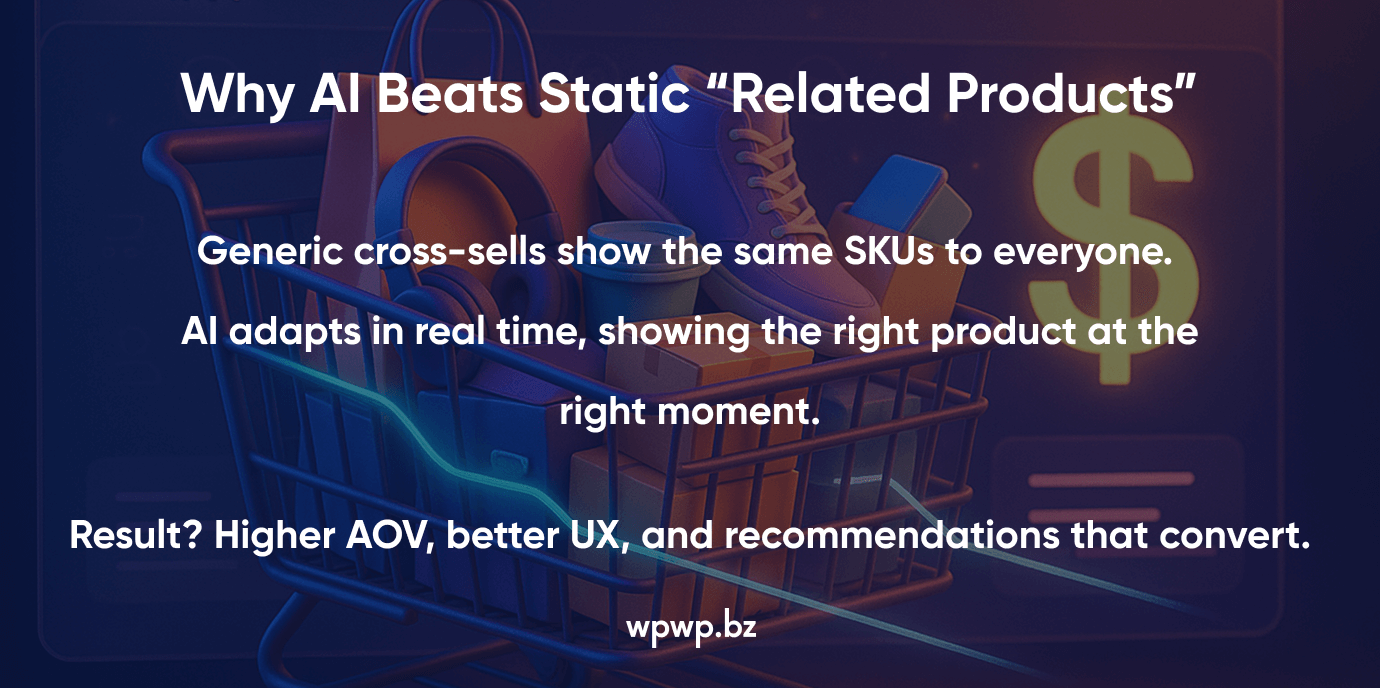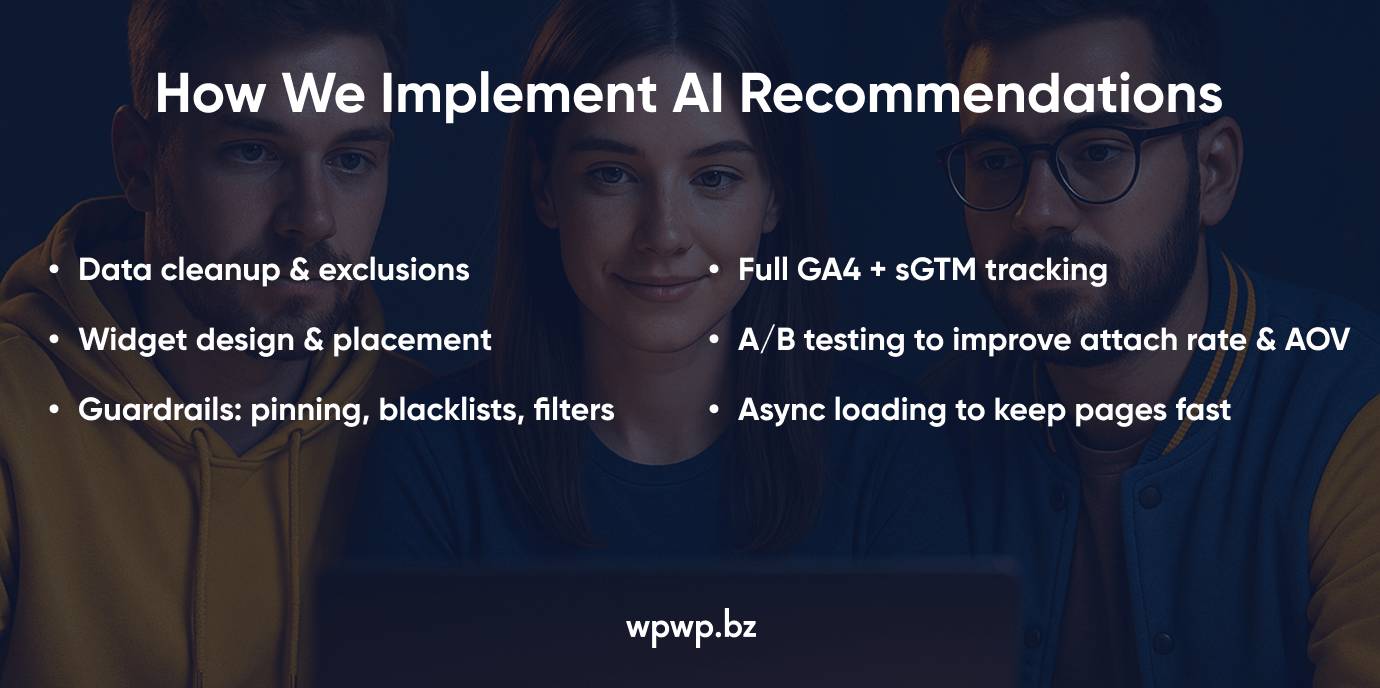With AI product recommendations for WooCommerce, you can replace guesswork with personalization. A hybrid approach, combining machine learning with clear merchandising rules, ensures every placement is relevant, brand-safe, and optimized for performance. Think “frequently bought together AI WooCommerce” bundles on PDPs, smart cross-sells in the mini-cart, and tailored add-ons at checkout, powered by AI for Ecommerce.The outcome is measurable. Every widget view, click, and add-to-cart can be tracked in GA4, proving the uplift in AOV and attach rate. Instead of hoping your cross-sells convert, you’ll know exactly which placements drive incremental revenue and scale them across your store, backed by WordPress SEO tools integration and clean analytics setup.

Who This Service Is For
This service is built for WooCommerce stores that need more than a basic “related products” box. If you manage a catalog from 200 to 50,000+ SKUs, launch new items frequently, or run multi-locale sites with different languages and currencies, AI recommendations help you keep control while driving growth. It’s designed for teams with measurable targets — higher AOV, stronger attach rates, and clear proof in GA4, who want scalable, data-backed personalization instead of guesswork.
Why AI Recommendations Beat Static Related Products
Static “related products” in WooCommerce often feel random, repeating the same SKUs regardless of customer behavior. They miss session intent — what a shopper is actually browsing for in that moment, and ignore opportunities to increase cart value. AI product recommendations for WooCommerce solve this gap by analyzing behavior in real time, adapting suggestions to match context, history, and buying patterns.
AI also adds diversity and novelty, preventing the same items from showing repeatedly while balancing relevance with discovery. It’s price- and variant-aware, meaning customers see the right size, color, or bundle at the right stage of their journey. Even the cold-start problem, when new products lack data, can be handled through hybrid governance, where AI works alongside merchandising rules, guardrails, and manual pinning.The result is a personalized product recommendations WooCommerce engine that feels intelligent, brand-aligned, and sales-driven, outperforming static cross-sell setups every time, especially when extended with custom WooCommerce plugin development for bespoke logic and placements.
Placement That Converts
Where you place recommendations often matters more than the algorithm itself. Think about the moments when shoppers are already considering a product. On the product page, a simple “complete the look” block works because it feels like advice, not a sales pitch. Category pages are another natural fit — they let people notice accessories or complementary items while they’re already in browsing mode.
The cart is where timing gets interesting. In a slide-out drawer or mini-cart, a few quick suggestions can turn into easy wins. By the time someone reaches checkout, you don’t want to overwhelm them, but a small add-on — batteries, refills, an extended warranty, usually lands well. Even after the payment is done, the thank-you page can plant the seed for a follow-up order, and an email a day or two later can keep that momentum going.
The trick is restraint. Show too much and it feels pushy; repeat the same product in different spots and it comes across lazy. Keep it light, mobile-friendly, and relevant. Done right, recommendations feel less like marketing and more like a natural part of the shopping flow and that’s exactly why they lift sales without drawing attention to themselves.

Options: Native vs SaaS
Adding product recommendations in WooCommerce can be done in a few different ways, and each path has its own trade-offs.
Native plugins are the starting point for many stores. Woo AI Product Recommendations links to an OpenAI key and lets you drop widgets in with shortcodes or quick toggles in the admin panel. It’s simple, light, and good for testing. Woo Product Recommendations takes a different approach: it runs on rules and segments, giving you control over what appears before or after checkout and letting you shape the logic yourself.
SaaS platforms like Clerk.io, Klevu, Luigi’s Box, or Doofinder go further. They pull in your product feed, render suggestions through JavaScript placeholders, and usually ship with GA4 tracking built in. They can be quick to roll out and come with polished dashboards, but they lock you into a subscription and leave less room for fine-tuning.
When choosing, think about four things:
- Speed — SaaS can be live in days, while plugins need more setup.
- Control — rules in WordPress let you govern results; SaaS is more of a black box.
- Budget — plugins are cheaper up front; SaaS costs rise with catalog size.
- Analytics & team fit — SaaS has strong reporting, but if you want everything under your WordPress roof, native may suit you better.
There’s no single best option. The right choice is the one that balances cost, flexibility, and the level of measurement your team actually needs.
Our Implementation Workflow
Rolling out product recommendations isn’t just dropping a plugin and hoping for the best. To actually lift revenue, we follow a clear workflow that balances automation with control.
Data prep
It starts with the catalog feed. We clean the data, set up exclusions, and make sure out-of-stock items don’t slip into recommendations. Language and currency settings are also aligned early, so results make sense across different locales. For stores that also need better product copy at scale, we tie in AI product description generation for WooCommerce to strengthen PDP relevance.
Build & slot widgets
Next, we design and place the widgets. A PDP block looks different from a mini-cart suggestion, so we map each placement by page type and device. Fallback rules cover edge cases, for example, when AI doesn’t have enough context.
Guardrails & QA
AI can’t run without boundaries. We apply pinning for must-show products, blacklists for restricted items, and filters for price bands or brand safety. Then each widget goes through QA to confirm it behaves as expected.
GA4 + sGTM tracking
Every view, click, and add-to-cart action from these widgets is tracked in GA4. Server-side GTM (sGTM) helps capture assisted revenue and experiment IDs, giving you real proof of incremental lift.
A/B testing cadence
We don’t just launch and leave it. Variations in copy, placement, or item count are tested regularly, so you see which combinations drive the best attach rate and AOV.
Performance
Finally, we keep performance front and center. Widgets are loaded async or via lazy-load, so Core Web Vitals stay healthy and pages don’t stall. Staging, QA, and production pipelines ensure changes roll out safely.
This process turns recommendations from a nice-to-have feature into a measurable growth engine — fast, controlled, and performance-first.

Multilingual & Catalog Nuance
Shoppers expect to see products in their own language, currency, and format — anything less feels off. That’s why we set up recommendations through WPML or Polylang, making sure product titles, attributes, and prices are localized properly. Even small details, like units of measure or how the currency is displayed, can influence trust and conversion.
The catalog itself also needs nuance. What works for one industry rarely works for another. A beauty brand might link items into a daily routine — cleanser, toner, moisturizer. An electronics store has to think about compatibility: the right charger for a laptop, or the right case for a phone. Furniture retailers often benefit from showing bundles — a sofa with matching chairs or a dining table with a set of stools. When recommendations reflect the context of both market and product, they stop feeling like generic add-ons and start acting like helpful suggestions.
Analytics & Proof
Adding recommendation widgets is only worthwhile if you can show they’re making a difference. That starts with tracking. Each view, click, and add-to-cart from a widget is tagged in GA4, giving a clear picture of how shoppers interact with suggestions.
From there, we build simple experiments — a control version against a variant, so you see what’s driving the change rather than guessing. The results flow into dashboards that highlight the numbers that matter most: click-through rate, attach rate, and extra revenue those widgets generate.
The real value comes when those metrics tie back to business outcomes like average order value. Instead of “we think it’s working,” you get proof of how each placement is lifting sales, and a clear view of where to test next.
Ready to upgrade?
WPWP.BZ can implement AI-Powered WooCommerce Product Recommendations & Cross-Sell directly in your store. Start with a free 14-day pilot: we’ll configure 1–2 placements, connect GA4 tracking, and share a clear report on the uplift.











